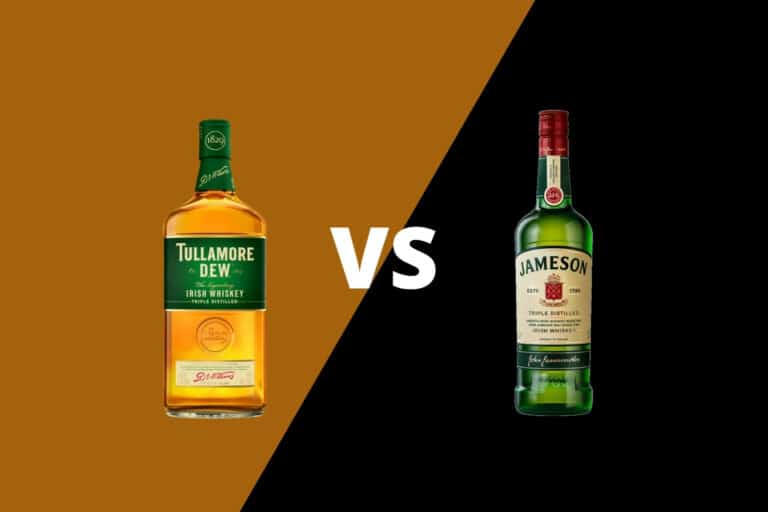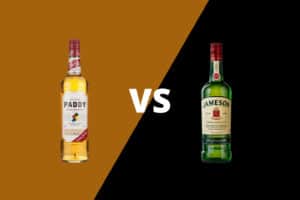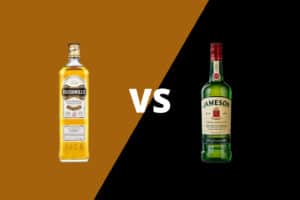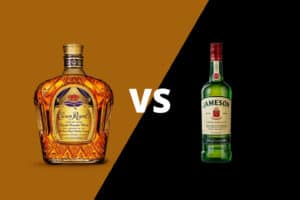Today, we look at two of the biggest names in Blended Irish Whiskey: Jameson and Tullamore DEW.
These two brands are the leaders when it comes to Irish whiskey sales. Jameson whiskey is the No. 1 selling brand in the United States, with Tullamore DEW following behind. In this post, we’ll compare them side-by-side so you can learn more about what is inside the bottle. We’ll look at the history of Irish whiskey and the role these two brands had in keeping alive the traditions of this spirit category. And, well dive into their production and how that impacts the overall flavor in your glass.
Note: The ‘Dew’ in Tullamore DEW reflects the initials of Daniel E. Williams, manager and owner of the original Tullamore distillery. Although it’s pronounced ‘dew,’ like the condensed water vapor that clings to morning grass, the label actually reads ‘Tullamore D.E.W.’ with the periods deemphasized through font and color so that they’re barely legible. But we’re going to be honest — it’s quite time-consuming to type those periods on each mention. So, to save some time on the ol’ typewriter, we’re going with ‘Tullamore DEW’ throughout.
Table of Contents
History
The history of Irish whiskey has been a rollercoaster, and — as the largest brands in the category — Jameson and Tullamore DEW had front row seats on the ride.
The history of Irish whiskey is nearly 1,000 years old. It began with the introduction of distillation from proselytizing Christian monks and grew alongside scotch as an industry that for centuries had one foot in the world of global supply chain and the other in the trade of illicit hooch — or Poitín in Irish.
For a time during the 19th and early 20th centuries, Irish whiskey was considered the highest quality — the envy of distillers in Scotland and America. But a number of changes to the industry hurt their market dominance. The invention of the modern Coffey still, Irish independence and the British naval isolation that followed and American prohibition created a perfect vortex to pressure the industry. Consolidation was the result, with brands uniting under the Irish Distillers Group. At one time in the 1980s, Jameson was the only Irish whiskey available.
A marketing campaign centered around Irish whiskey helped the category begin to claw its way back and allowed Irish whiskey to hang around until the whiskey renaissance that began in the 2000s lifted all boats and gave rise to new craft distilleries that reflect the interest in whiskey across the globe.
Mashbills
Blended Irish whiskey is a type of whiskey that is made up of a combination of various component whiskeys.
Jameson is made of a combination of single pot still whiskey — a type of whiskey unique to Ireland with a mash bill or list of grain ingredients that includes malted and unmalted barley produced in a traditional copper pot still — and grain whiskey made in a column still. The grain whiskey mash bill used in Jameson includes about 95 percent corn and 5 percent malted barley.
Although Tullamore has had to source grain whiskey from the New Middleton Distillery, they have announced that once the new grain distillery is operational, they will make whiskey using Irish-produced wheat grain — not corn.
Distillation
While much of today’s Irish whiskey industry is moving away from the ‘triple distilled’ terminology that has become a familiar narrative, Jameson and Tullamore DEW both lean into it. In marketing material and on the label, the words’ triple distilled’ are prominently featured.
This might reflect their position as the Nos. 1 and 2 brands globally. But it’s important to remember that triple distillation is not mandated by Irish law, and many smaller brands use various distillation techniques, including double pot still distillation.
For a time, both Jameson and Tullamore DEW are produced at the New Middleton Distillery in County Cork following the creating of Irish Distillers. But after William Grant & Sons purchased the brand, production was moved to a brand new facility near Tullamore, County Cork, which opened in 2014.
For now, the grain whiskey component continues to be sourced from Middleton, with an expanded column still expected to be installed at the Tullamore site in coming years.
Blended Irish whiskeys like Jameson and Tullamore DEW are produced by combining single malt, single pot and/or grain whiskeys. The single pot components are distilled by using three passes on a traditional copper pot still. The grain whiskey is made using three separate column stills: first a beer column, then an extractive distillation column and finally a rectifying column.
A column still is a modern distillation system that is cylindrical in shape and has a series of lateral plates that perform multiple distillations as stem rises, re-condenses and redistills on each plate as it moves upwards in the system. Vapors concentrate in alcohol strength as it rises, and water and other non-alcoholic liquids fall downwards.
The New Middleton Distillery uses a modern column still setup described as a continuous column system — in which feedstock — terminal beer — is fed into one side and the clear, or ‘white,’ newmake spirit comes from the other end. This system can crank out spirits 24 hours a day and 7 days a week if distillery management decides and is only shut down for cleaning and maintenance.
In the beer column, terminal beer — including solids — are fed into the system at about 15 percent alcohol by volume, or 30-proof. After the first distillation, the spirits described as beer-column high-wines come off the still at about 75 percent ABV or 150-proof. For the second distillation, these high wines are fed into the second still and combined with water to remove high-volatiles, heads and congener impurities using chemical bonding principles. As a result, the second distillation lowers the alcohol volume to about 25 percent ABV or 50-proof. The result is called ‘the pinch.’ The pinch is then fed into the rectifying column, which further concentrates the ethanol and removes any remaining impurities before leaving the distiller with a new make white spirit at just below 95 percent ABV or 190-proof.
Maturation & Blending
Irish whiskey requires the product to be matured for no less than three years in an oak cask. At least 90 percent of Irish whiskey is matured in a used bourbon barrel due to the requirement in the United States that bourbon is matured in new American oak. Distillers in Ireland, Scotland, Japan and other whiskey-producing nations reap the benefits of this requirement by picking up bourbon barrels on the cheap on the secondary market.
While nearly all Irish whiskey touches a bourbon barrel at one point, producers also utilize finishing barrels to impart flavors of sherry, port and other wines by reusing casks previously used to age these beverages. After being matured for years in a bourbon barrel, whiskey barrels or a blend of various barrels are transferred into these finishing casks for anywhere between a few months to multiple years.
Neither Jameson nor Tullamore DEW have age statements. We know that both have been matured for at least three years. But beyond that, we cannot be sure the length of time the barrels that go into each batch have been matured.
Ownership, Price Point & Value
Jameson is produced by Irish Distillers Limited, a subsidiary of the French distilled spirits and liqueurs conglomerate Pernod Ricard.
Tullamore DEW is produced by family-owned William Grant & Sons, a Scotland-based distilled spirits company.
In addition to Irish whiskey, both companies are heavily invested in the scotch whiskey trade. Pernod Ricard and William Grant & Sons are the Nos. 2 and 3 makers of scotch whisky, respectively, behind global giant Diageo. In addition to the globally popular Grant’s Blended Scotch, additional brands in the William Grant & Sons portfolio include Glenfiddich, The Balvenie and Monkey Shoulder. Pernod Ricard scotch brands include Ballantine’s Chivas Regal and The Glenlivet, and they also produce Irish whiskey brands Powers and Redbreast.
Jameson will cast about $28 for a 750mL bottle at 80-proof.
Tullamore DEW will cost about $32 for a 750mL bottle at 80-proof.
Tasting Notes
Tullamore DEW Blended Irish Whiskey
Description: Legs are medium at 80-proof. The color is like amontillado sherry and the hue is straw-gold.
Nose: A nice sandalwood note from bourbon and sherry oak, a roasty note that might be from the green malt and a floral note with some citrus peel.
Tongue: Rich and sweet, with caramel, honey and toffee.
Finish: Mild smoke, with honey and golden raisins.
Jameson Blended Irish Whiskey
Description: The color is deep copper, the hue straw-gold. Legs are medium at 80-proof.
Nose: An oak richness, with the aroma of smoky embers. A lingering note of figs.
Tongue: Light and delicate mouthfeel, a bit of oak, gunpowder, mild coconut and white vanilla.
Finish: A finish of charcoal with chocolate and vanilla.
Verdict…
Jameson and Tullamore DEW Irish whiskey are excellent examples of the Irish whiskey category. For that reason, they have an impact on the on-premise sector, and hospitality industry professionals understand the important role they play behind the bar. Their availability makes them an excellent opportunity for a Blended Irish Whiskey 101 blind tasting to see which you prefer.
Whiskey drinkers have been familiar with Jameson as a popular shot call. But, at the same time, the rich mouthfeel and luscious caramel notes make Tullamore DEW a great choice for cocktails, including a highball made with ginger ale. So the next time you’re at your favorite bar, try either of these blended whiskey options to see how the unique triple-distilled spirit differs from other types of whiskey like bourbon and scotch.

















